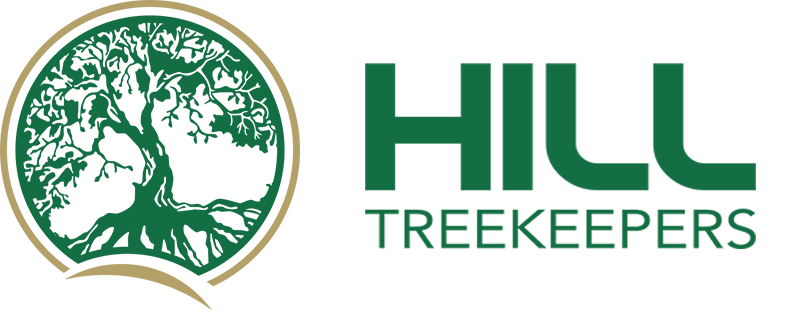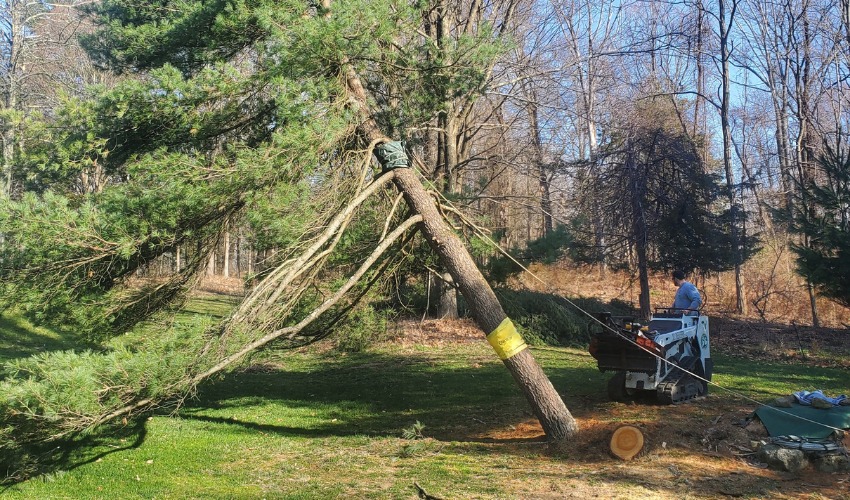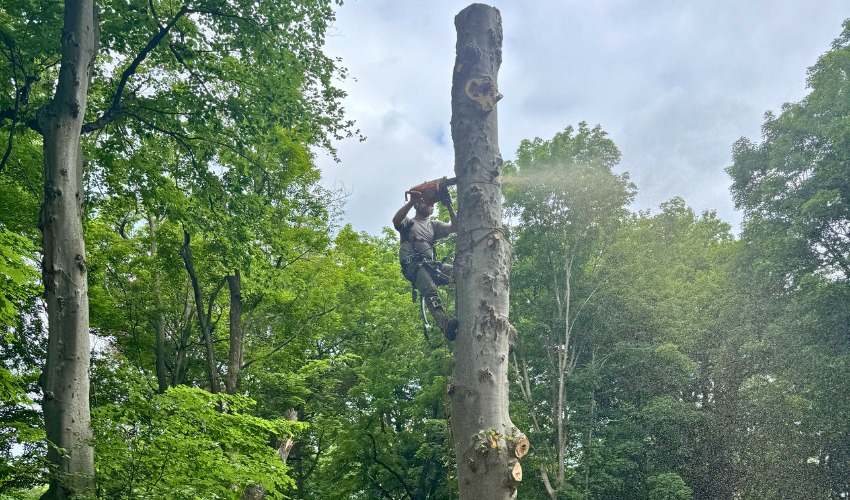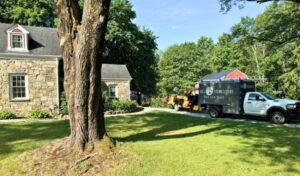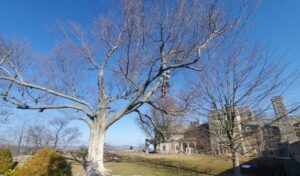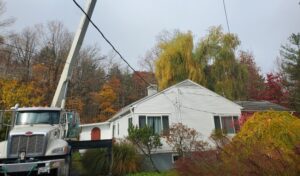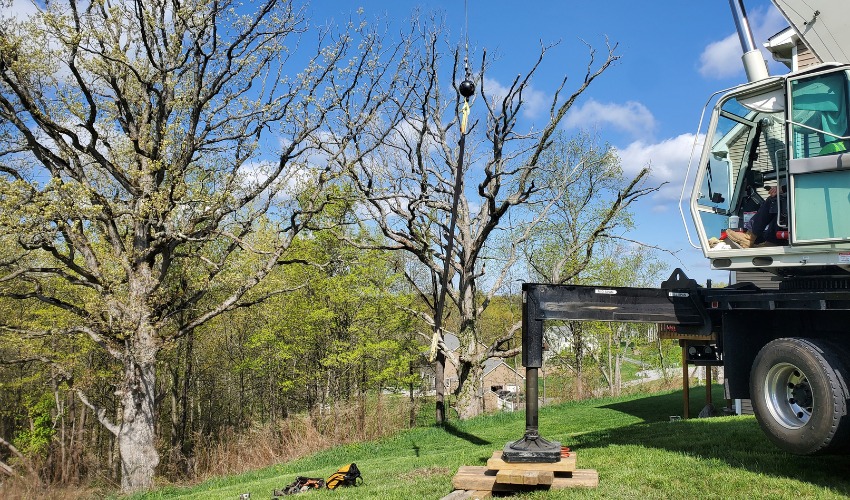
Has your tree seen better days? Whether it’s leaning, dropping limbs, or just looking downright lifeless, a problem tree can quickly become a hazard. While not every tree issue calls for removal, some situations pose serious risk to your home, your safety, and even other trees on your property. A tree can’t warn you before it fails, but these signs will.
Key Takeaways
- Dead trees should be removed quickly before they become dangerous.
- If a storm leaves less than half of a tree’s canopy intact, it likely needs to be removed because it can no longer produce enough energy to survive.
- Remove invasive species, such as Norway maple, tree of heaven, and Russian olive, to prevent them from crowding out native Hudson Valley plants and reducing local biodiversity.
- Trees growing within 10 feet of homes or utility lines pose safety risks and may require removal if pruning cannot adequately address the encroachment issues.
- Only a professional arborist can fully assess whether a tree can be saved, since hidden issues like root damage, pests, or soil problems often play a role.
7 Clear Signs of Tree Removal You Can’t Ignore
Choosing when to remove a tree is often a difficult decision for homeowners. In addition to all the benefits trees provide, it may have been a fixture on their property for years and holds sentimental value.
However, there are instances where removing a tree is the only viable option. Not only will it keep you safe, but it will also give you new room to develop your property. Some of the reasons we recommend tree removal to Hudson Valley homeowners include:
1. The Tree Is Completely Dead
The most obvious reason to remove a tree in the Hudson Valley is if it is dead. We can do a lot to save a tree, but we aren’t miracle workers. A dead tree won’t recover, and it will gradually lose structural integrity and become more at risk of falling.
Dead trees can be difficult to remove. Due to the danger they pose, we can’t always use some of our go-to methods for tree removal. For instance, climbing in the tree can be hazardous, as the branches may no longer be able to support an adult’s weight. This can make the removal process more hazardous and time-consuming for our team.
2. Major Storm Damage Left the Tree Bare or Broken
Storms (like the large one we saw in the summer of 2024) can cause massive damage to trees from high winds or lightning. While trees have natural defenses that can help them survive a storm (such as flexible branches), these can only go so far to protect the tree.
Arborists typically examine the canopy for clues as to whether a tree can survive storm damage. If 50 percent of the canopy remains intact, the tree will likely survive the damage. Trees rely on their leaves to perform photosynthesis, which produces energy. With enough healthy branches intact, the tree can usually bounce back.
However, larger wounds from branches tearing off will take much longer to heal and leave it susceptible to insect and disease attacks. And the heavy rain might have compacted the soil and left the roots struggling to survive. If your tree is looking worse for wear after a storm, have a professional conduct an arborist consultation. They’ll examine your trees and determine whether they can survive or if removal is the best option.
PRO TIP: Want to learn more about how storms affect your trees? See our previous article on how trees deal with stormy weather.
3. It’s an Invasive Species Crowding Out Native Plants
Some trees don’t belong in our local landscape. Invasive species often proliferate aggressively and have no natural counters. They tend to elbow out native species and can lead to lower biodiversity in our region. Some invasive species in the Hudson Valley we recommend identifying and removing include:
- Norway maple
- Tree of heaven
- Russian olive
- Smooth buckthorn
- Black locust
- Bradford pear
4. Branches Are Growing Too Close to Your Home or Utility Lines
Trees like to spread their branches and roots far in search of sunlight and nutrients to support their size. The expansion of branches will sometimes lead to them encroaching on your home or getting entangled in power lines, causing power outages or damage to the roof, windows, or siding of your home.
Pruning these branches can help prevent the damage, but it may only be a temporary solution. If the tree is too large for the space where it resides, removing it may be the only option to protect your home from harm. The general rule of thumb for branches is that they should be at least 10 feet away from the roof or side of your house.
Removing trees close to your home can be a time-consuming and challenging process. We typically use our tree removal crane to make the job easier and safer.
5. Pests or Disease Are Killing the Tree
The Hudson Valley is home to some beautiful natural environments. Unfortunately, much of that natural beauty is at risk from dangerous pests and diseases. Some of these can kill a tree and leave it struggling to remain standing.
Take the emerald ash borer as an example. This pest has killed countless ash trees throughout our region, necessitating removal. Many neighborhoods in the Hudson Valley have seen their ash trees almost entirely wiped out by this pest.
6. The Tree Is Leaning More Than It Used To
Some trees have a natural lean, and that’s usually fine. But if a tree starts leaning suddenly, or the angle increases over time, that’s a red flag. It could mean the root system is failing or the soil has shifted. A tree leaning more than 15 degrees is often unstable and may need to be removed before it falls unexpectedly.
7. It’s Smothering Your Yard or Garden
Many homeowners dream of having a large shade tree on their property as a central feature of their landscape. However, these large species can end up casting too much shade, making it difficult for your other specimens to grow. Their roots may also have expanded so far that they prohibit other saplings from establishing themselves in your landscape.
While it may be unfortunate to remove a healthy tree, it is sometimes the only way to allow the rest of your landscape to thrive. You can replace it with a smaller species or instead, plant a shade tree in a different area where its shade won’t affect the other plants.
Frequently Asked Questions About Removing Trees in the Hudson Valley
Understanding when to remove a tree can be difficult, so we’ve answered some common questions from homeowners to help you understand why we do it.
Is there any way to save a tree that is dying?
It depends on what’s causing the decline. Some trees can be saved with the right care, while others may already be too far gone. When possible, we use techniques like:
- Cabling and bracing mature trees with weak sections
- Pruning trees to improve their vigor
- Insect and disease treatments for at-risk species
Is it bad to remove a tree?
No, it’s not bad to remove a tree, especially when you have a good reason for it. Removing a tree can protect your property from damage and allow you to replace it with a more suitable species that better suits your yard’s space requirements.
What are some good ideas for replacement trees in the Hudson Valley?
If you want to replace your tree with another deciduous species, consider one of these native species:
- Black oak
- Red maple
- Shagbark hickory
If you are looking for something more compact, consider some of these evergreen shrub options:
- Yew
- Inkberry
- Bayberry
Not Sure if That Tree Needs to Go? Let Hill Treekeepers Take a Look
If one of your trees is showing signs of decline – or just making you uneasy – it’s better to get it checked before the situation gets worse. Our ISA Certified Arborists will give you a straightforward, expert opinion on whether the tree can be saved or if removal is the safest choice.
If it does need to come down, Hill Treekeepers has the tools and experience to do it safely, efficiently, and with respect for your property. Call us today at 914-214-7045 or request a quote online.
Share this online!
Get the highest quality of tree services for residential and commercial properties in the Hudson Valley area. We look forward to working with you!
TOPICS
Recent Articles
Don't Miss the Next Update!
Join the thousands of smart Hudson Valley residents who get the monthly newsletter from Hill Treekeepers. It's full of helpful information you won't want to miss!
